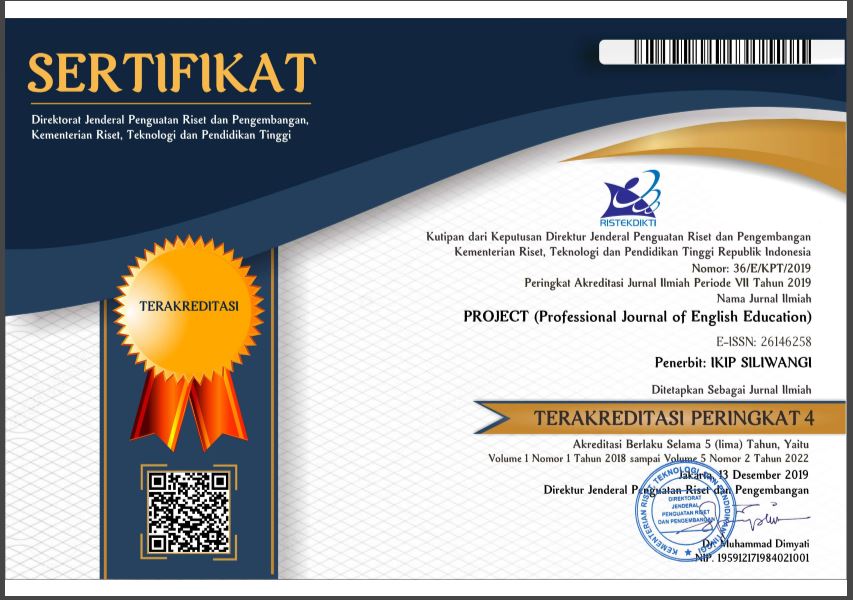DESIGNING PAV (PASSIVE AND ACTIVE VOICE) BOARD AS A MEDIUM FOR LEARNING PASSIVE AND ACTIVE VOICE FOR THE ELEVENTH GRADE STUDENTS
Abstrak
Media can be used as an aid in supporting teaching and learning English at school. However, there are still a few media variations used to deepen the student’s understanding of the material. This study aimed to design PAV (Passive and Active Voice) Board as a medium to help students in Grade XI of SMAN 10 Pontianak learn and deepen their understanding of passive and active voice. This study used ADDIE as the research model with three phases: Analysis, Design, and Development. The data were collected by distributing the need analysis questionnaire to the 31 students in Grade XI IPS 1 of SMAN 10 Pontianak and an internal evaluation questionnaire to an English teacher of SMAN 10 Pontianak. The finding showed that students need a medium that can support them in learning passive and active voice which are changing active voice into passive voice, remembering the formula passive and active voice, identifying the subject, to be, verb 1, verb 2, verb 3, object, object pronoun, and preposition, and for PAV Board as a medium had a good score from the evaluator in criteria of the content, language, visual appearance, and product guide, which is 3.61 that categorized as "Strongly Worth”. In conclusion, designing PAV Board as a medium for learning passive and active voice was appropriate.
Referensi
Aldoobie. (2015). ADDIE model. American International Journal of Contemporary Research ADDIE, 5(6), 68–72.
Branch, R. M. (2009). Instructional Design: The ADDIE Approach. Springer Science & Business Media.
Ekaningsih, N. (2017). Enhancing students’ english grammar ability with on-line website link. Journal of English Education, Literature and Culture, 2(2), 431-444. http://dxx.doi.org/10.30659/e.2.2.431-444
Dhamayanti, I. F. (2021). EFL students’ perception and motivation toward quizizz as e-learning media in english e-classroom. Education of English as Foreign Language, 4(2), 71–78. https://doi.org/10.21776/ub.educafl.2021.004.02.03
Manurung, D. S., Lestari, L., & Manik, M. E. (2020). Students’ errors analysis in changing active voice into pass,ive voice of simple present and past tense. EJI (English Journal of Indragiri): Studies in Education, Literature, and Linguistics, 4(1), 134–144. httpss://doi.org/10.32520/eji.v4i1.859
Marpanaji, E., Mahali, M. I., & Putra, R. A. S. (2018). Survey on how to select and develop learning media conducted by teacher professional education participants. Journal of Physics: Conference Series, 1140(1). https://doi.org/10.1088/1742-6596/1140/1/012014
Oroujlou, N. (2012). The importance of media in foreign language learning. Procedia - Social and Behavioral Sciences, 51, 24–28. https://doi.org/10.1016/j.sbspro.2012.08.113
Paranoana, E. (2020). Penguatan kalimat passive voice dalam penayaan materi bahasa inggris di SMA PGRI Waena. Abdimas Dinamis: Jurnal Pengabdian Kepada Masyarakat, 1(2), 27–34.
Preeti. (2014). Education and role of media in education system. International Journal of Scientific Engineering and Research, 2(3), 174-175. http://www.ijser.in/archives/v2i3/SjIwMTMxNTg=.pdf
Purwatiani, F. (2019). Developing grammar board game as a media in learning english grammar. Journal of English Language Teaching Learning and Literature, 3(1), 38–47. https://journal.stkippgritrenggalek.ac.id/index.php/kid/article/view/163
Richards, J. C., & Reppen, R. (2014). Towards a pedagogy of grammar instruction. RELC Journal, 45(1), 5–25. https://doi.org/10.1177/0033688214522622
Ritakumari, S. (2019). Educational media in teaching learning process. Bhartiyam International Journal of Education & Research, 8(3), 7–14. http://www.gangainstitueofeducation.com/documents/Singh-Ritakumari.pdf
Sofiana, N., Mubarok, H., & Yuliasri, I. (2019). English Language teaching in secondary schools: An analysis of the implementation of Indonesian ELT 2013 curriculum. International Journal of Instruction, 12(1), 1533–1544. https://doi.org/10.29333/iji.2019.12198a
Ukhrowiyyah, L. I. (2020). Developing duel chess game as a media in learning passive voice. LinguA - LiterA, 4(1), 46–58. https://jurnal.stkippgritrenggalek.ac.id/index.php/lingua/article/view/218
Wijaya, H., & Sari, D. P. (2016). Making of jfg (jumanji for grammar) board game to learn grammar for university students. Inovish Journal, 1(2), 86-97. http://ejournal.polbeng.ac.id/index.php/IJ/article/view/86
Unduhan
Diterbitkan
Terbitan
Bagian
Lisensi
Hak Cipta (c) 2023 PROJECT (Professional Journal of English Education)

Artikel ini berlisensiCreative Commons Attribution-ShareAlike 4.0 International License.




